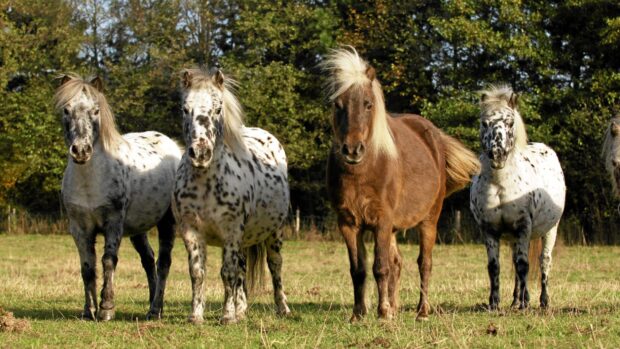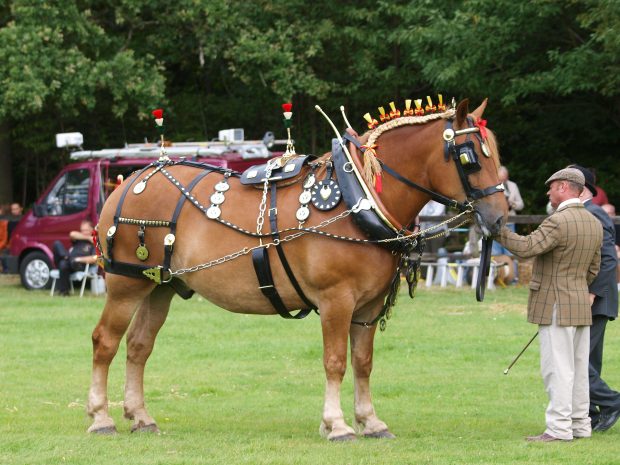A practical build, a wide-ranging ability and a bright, friendly demeanour – there’s lots to love about the Haflinger horse. Combining the hardiness to withstand their mountainous origins and enough athleticism to support all types of work, the Haflinger can be found in all manner of equestrian settings from the hacking home to the show ring.
History at a glance
The Haflinger horse comes from South Tyrol, a mountainous region located in northern Italy next to the Austrian border. The breeds origins are believed to date back to the Middle Ages, but the modern Haflinger can be traced back to 1874 and the birth of a golden colt called 249 Folie. Sired by an Arabian stallion, 249 Folie became the breed’s foundation stallion.
By 1904, the first Haflinger Studbook of 250 horses was introduced by the Meltina/Mölten First Association of Haflinger Breeders. Haflinger horse breeding took off for a time with support from the Ministry for Agriculture of the Austro-Hungarian Empire, but programmes were interrupted by the outbreak of the First World War, when many Haflingers were seized by the army.
The region of Tyrol was once part of Austria-Hungary, a nation defeated by Italy in November 1918. Italy’s occupation and subsequent annexation of South Tyrol caused upheaval in Haflinger breeding efforts. In the main, this was caused by the separation of Haflinger population – most breeding stallions were located in North Tyrol, which remained within Austria, while the broodmares were kept South Tyrol. Lack of co-operation between the two regions damaged breed numbers, but throughout the 1920s and 30s several breeding efforts were established on both sides of the border and Haflinger breeding spread into Germany and beyond.

Two riders on Haflinger horses cantering in a stubble field. Credit: Alamy
Conformation of the Haflinger horse
Height: Haflingers should be no more than 155cm (15.1hh) in height. The ideal height for stallions is between 146–152cm and for mares it is 145–150cm.
Colour: all shades of chestnut, from pale to dark liver, are encompassed by the breed specifications. However, the colour should be uniform – white hairs or dorsal stripe are not desired traits. Head markings, such as a blaze or star, are part of the breed standard, but leg markings are not. The main and tail are always flaxen and should be long, straight and flowing.
Head and neck: a refined and noble head is desirable with a flat, broad forehead. The ears should be well-proportioned and flexible, the chin small and the throat latch wide. The neck is well-set and of medium length with a slim nape and flexible poll.
Limbs: these should be refined and muscular, and of proportional length to the body. The shins should be strong and the tendons defined. Fetlock should be sufficiently long and delicate feather is to be expected.
Body: the shoulders should be long and sloping and the back firm and well-muscled. The loin is short and wide, connecting gracefully to the quarters with a short flank. The barrel is long and deep with a longitudinally oval ribcage.

Wolontair is a 12-year-old stallion owned by Joanne Critchlow. He was the top stallion in-hand at the 2023 breed show.
Uses
Coupled with his robust yet graceful physical attributes, the Haflinger’s easygoing, biddable yet courageous temperament makes him suitable for the full spectrum of equestrian disciplines. The breed’s uphill movement is ideal for dressage while his sturdy limbs and medium build make for an aptitude for athletic pursuits such as showjumping, eventing and endurance.
Haflinger horses are also widely used in driving, Western riding and even the lesser-known equestrian sports, such as skijoring and traditional Tyrolean trot and gallop races.
Their kind, calm and friendly natures make them, when trained, the perfect horse for novices and they can regularly be found in riding schools, trekking and equine-assisted therapy centres.

Ornella is owned by Joanne Collcutt, who says she is a true family pony.
A Haflinger horse enthusiast’s view
Petra Ingram, Chief Executive of HorseWorld and patron of the Haflinger Society of Great Britain, is a breed enthusiast and owns four Halfingers – Alfred (22), Otztaler Samalfi (3), Oxnead Odette (11) and Frohe Fantasie (10).
“You do end up collecting them,” she admits, “and they are very difficult to part with. That’s why there are so few mature Haflingers on the market – people buy them direct from the stud and keep them for life.”
Her involvement with the breed society means Petra experiences first-hand just how versatile Haflingers are. “My own Alfy was originally Western trained,” she explains, “now he hacks and does a bit of riding club and I do British Dressage (BD) Quest and Riding Club dressage with Odette.
“But there are active members of the society doing amazing stuff. The horses are often around 15-151.hh, so they’re a wonderful small adult size. We’ve got members who compete in everything you can think of – side saddle, agility, one-day eventing, you name it.
“The breeding is very well controlled. Horses are inspected at three to ensure future breeding stock is of high quality. We look at conformation, but temperament as well.”
While Haflingers are known to be loyal and good-natured, they have a reputation for being strong-willed, too. “You have to know what you’re doing, particularly if you’re getting a youngster,” advises Petra. “But they are beautiful souls who love to please.
Petra says the biggest challenge a Haflinger horse owner faces is maintaining their horse’s weight. “They’re such good doers, but they can happily live out, which helps keep them fit.”
“The most striking thing about the Haflinger is their ability — I know of Haflingers competing in dressage at advanced medium. They’re always happiest when they’re doing something, and when they have a really strong relationship with their rider.”

Equine vet Claire Brown and Oxnead Act One competing at the German Side Saddle International held at the Albert Vahle Halle, CHIO Aachen. Horse&Hound recommends wearing an up-to-standard safety helmet when mounted.
You may also be interested in…

The flashy Fjord: combining the prehistoric with a modern workhorse

About the Dales pony
HORSE magazine explains why the Dales pony is one of Britain's most valued native breeds.
Introducing the Eriskay pony
Looking at the least well known of the UK's native ponies – the Eriskay

Subscribe to Horse & Hound magazine today – and enjoy unlimited website access all year round
Horse & Hound magazine, out every Thursday, is packed with all the latest news and reports, as well as interviews, specials, nostalgia, vet and training advice. Find how you can enjoy the magazine delivered to your door every week, plus options to upgrade your subscription to access our online service that brings you breaking news and reports as well as other benefits.




